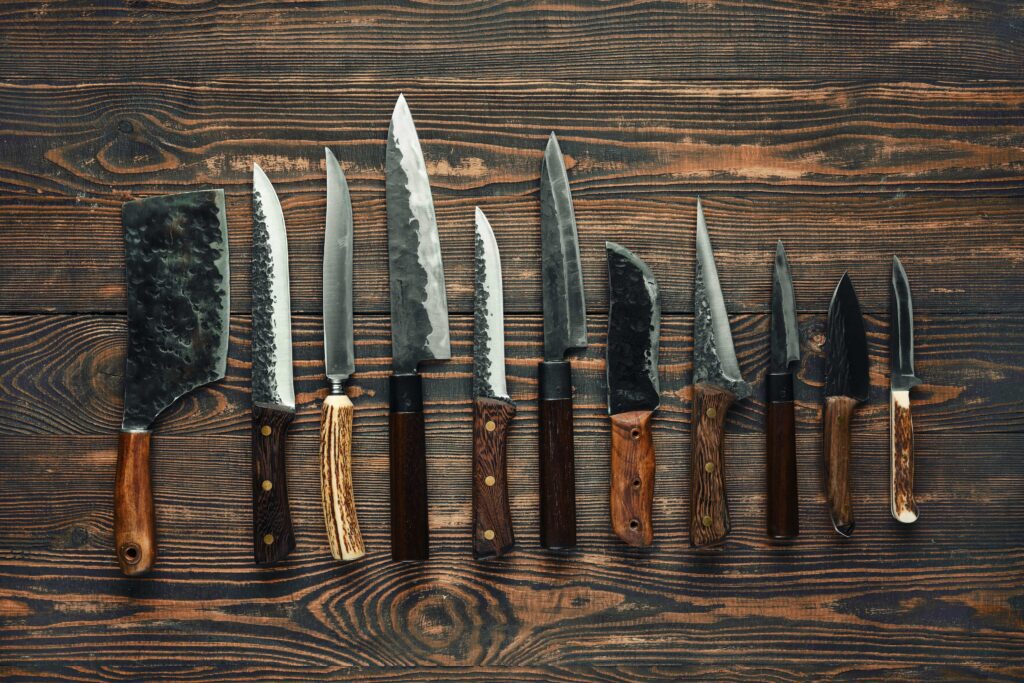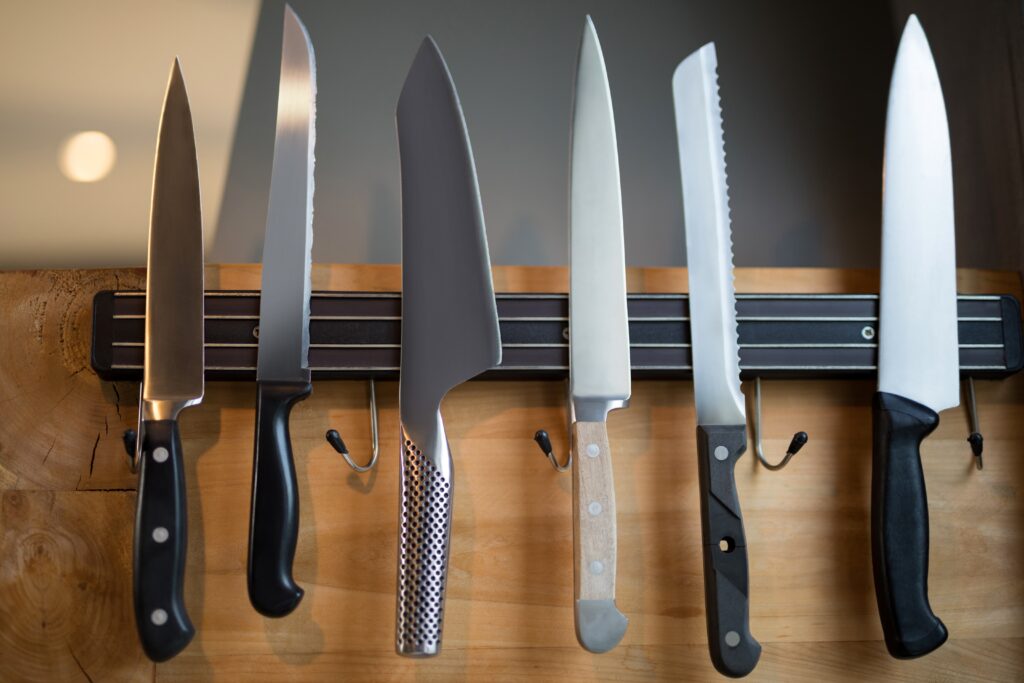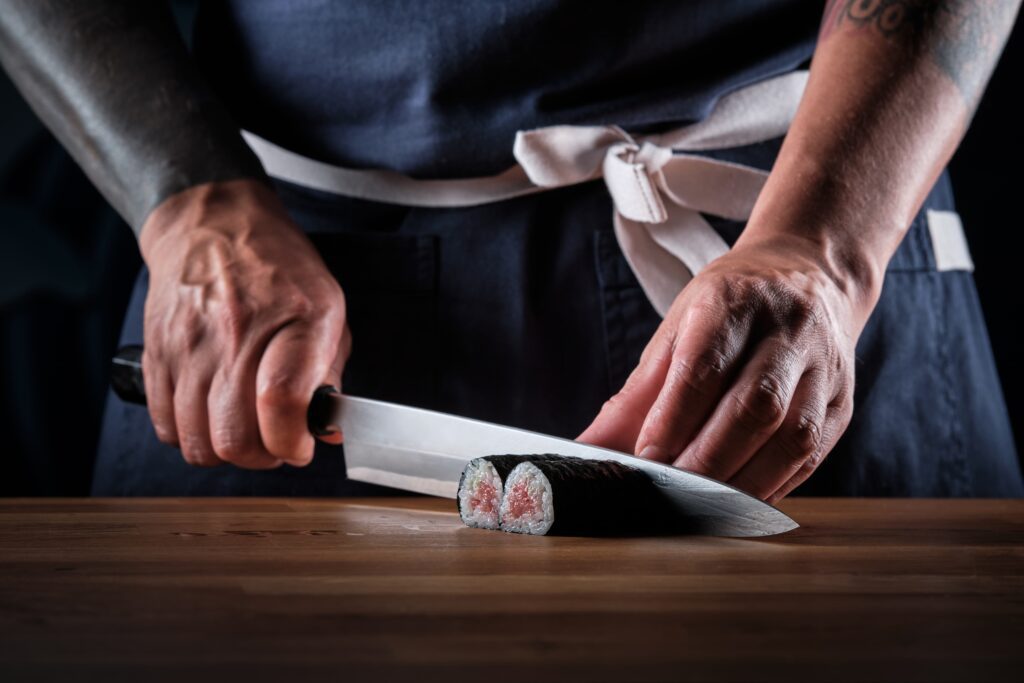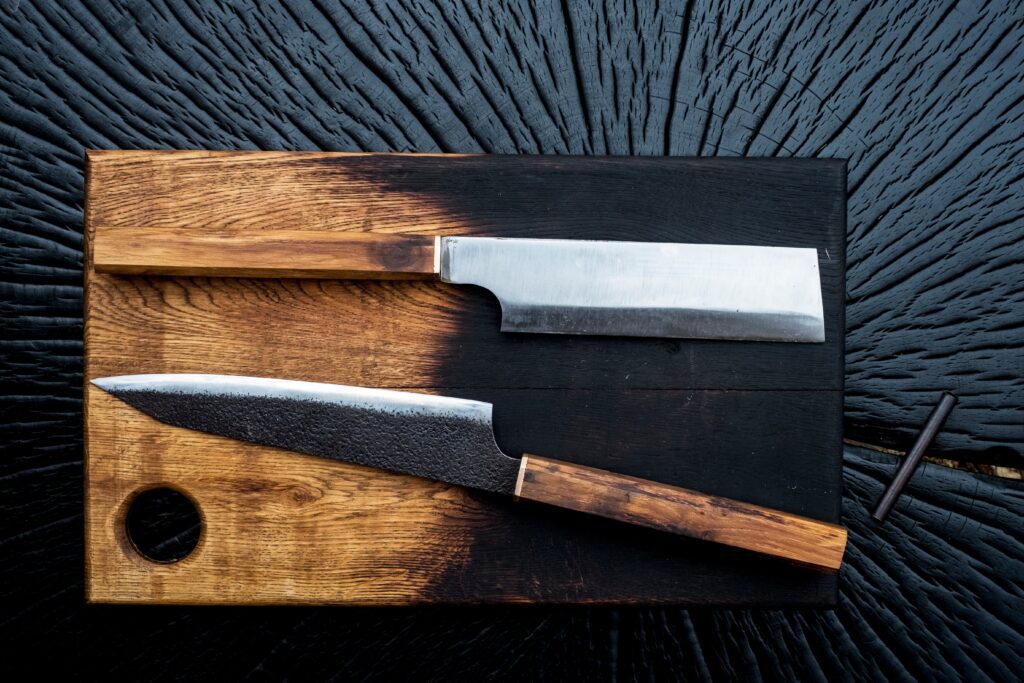Let’s cut to the chase – literally! With so many types of Japanese knives, it can be tricky to know their specific uses and how to wield them properly.
Japanese cuisine is renowned for its precision, artistry, and the harmonious balance of flavors. Central to achieving this culinary excellence is the mastery of specialized Japanese knives, each designed for specific tasks.
In this guide, we’ll explore:
- Common Japanese Knives
- Specialty Japanese Knives
- Essential Knife Skills
Now let’s get moving! Chop, chop!
Common Types of Japanese Knives
You might be used to the bread, butter, and steak knives in your kitchen, but Japanese knives take precision to another level. Just like TV chefs who rely on specialized blades for perfect cuts, Japanese chefs use expertly crafted knives to enhance their technique and elevate their dishes.

Gyuto
The Gyuto, translating to “cow sword,” is the Japanese equivalent of the Western chef’s knife.
It’s versatile and indispensable making it adept at slicing, chopping, and dicing a variety of meats and vegetables. Its balanced design and sharp edge make it a favorite among both professional chefs and home cooks.
Santoku
Meaning “three virtues,” the Santoku excels in slicing, dicing, and mincing.
This knife has a shorter, wider blade and a flat edge. These specs make it particularly suited for precision tasks and offers excellent control.The Santoku is typically used for cutting vegetables, fish, and boneless meats.
Nakiri
The Nakiri is a vegetable specialist. It has a straight-edged, rectangular blade. This formation allows for full contact with the cutting board.
Chopping and slicing vegetables can be described as effortless with a Nakiri knife. The design ensures uniform cuts, essential for even cooking and presentation.
Deba
Traditionally used for fish but versatile enough for poultry and meat, the Deba is a heavy, single-beveled knife.
Its sturdy blade is perfect for filleting fish, breaking down chicken and other poultry, and cutting through small bones, offering precision and power in one tool.
Yanagiba
The Yanagiba, or “willow blade,” is a long, slender knife primarily used for slicing raw fish and seafood. This makes it indispensable in sushi and sashimi preparation.
Its single-beveled edge ensures clean, precise cuts, preserving the texture and flavor of delicate ingredients.
Petty Knife
The Petty Knife is a small utility knife designed for intricate tasks.
Its smaller size is ideal for peeling, trimming, and delicate slicing. This compact design also offers excellent control, making it perfect for tasks that require precision, such as deveining shrimp or segmenting citrus fruits.
Specialty Knives
The basics and common types of anything is always a good place to start. Now we get into the specialty knives.
These knives are considered special for one of many reasons. They may only have one use, require a special training to use effectively, or even a status symbol.

Usuba
Similar in appearance to the Nakiri, the Usuba is a traditional vegetable knife used by Japanese chefs. The main difference from the Nakiri is the Usuba has a single-beveled edge.
Its sharpness allows for paper-thin slices, essential for decorative cuts and traditional Japanese vegetable preparations.
Kiritsuke
The Kiritsuke is a hybrid knife that combines features of the Yanagiba and the Usuba. With its distinctive angled tip and long blade, it’s used for slicing fish and vegetables.
Traditionally, it’s considered a status symbol in professional kitchens, often reserved for the executive chef.
Takobiki
A variation of the Yanagiba, the Takobiki features a squared-off tip and is primarily used in the Kanto region of Japan.
It’s designed for slicing octopus (tako) and other seafood, providing clean cuts without tearing the flesh.
Honesuki
The Honesuki is a poultry boning knife with a stiff, triangular blade.
Its pointed tip and sharp edge make it ideal for deboning chicken and other poultry, allowing for precise cuts around bones and joints.
Sujihiki
The Sujihiki is a double-beveled slicing knife, similar to the Yanagiba but with a Western-style design.
It’s perfect for slicing meats and fish, offering clean cuts with minimal friction, which is essential for preserving the integrity and presentation of the protein.
Essential Knife Skills
We have now gone over all of the specific types of Japanese knives, now let’s explore how to use and care for these knives.
Mastering the use of Japanese knives involves more than just owning them; it requires developing proper techniques to ensure efficiency, safety, and longevity of the blades.

Proper Grip
A correct grip on any knife provides control and reduces fatigue.
Hold the knife with your thumb and index finger pinching the blade just above the handle, while the remaining fingers wrap around the handle. This is called the “pinch grip” and offers stability and precision while cutting.
Cutting Technique
Now that you have your grip, it’s time to look into the type of cut you are making on your ingredients. Certain ingredients require specific cutting techniques depending on the type of Japanese knives you are using.
Using the wrong knife or cutting the wrong way can tear the meat or filet the vegetables incorrectly, making for a different taste and texture when eating.
Slicing
Use a smooth, forward motion, allowing the sharpness of the blade to do the work. Avoid pressing down forcefully, as Japanese knives are designed for precision slicing.
Chopping
For vegetables, employ a rocking motion, keeping the tip of the knife in contact with the cutting board. This technique ensures consistent cuts and maintains control.
Chiffonade
Stack leafy greens, roll them tightly, and slice perpendicular to the roll to create thin ribbons, perfect for garnishes.
Maintenance
Knives can be expensive depending on the types of Japanese knives you purchase. Proper care of your knives ensures their performance and longevity.
Sharpening
Regularly sharpen your knives. You can do this by using a whetstone.
Start by soaking the stone in water, then, holding the knife at the appropriate angle (usually 15-20 degrees), slide it along the stone in a consistent motion. Repeat on both sides if double-beveled.
Honing
Use a honing rod to realign the blade’s edge between sharpenings. Hold the rod vertically and draw the knife down at a consistent angle on each side.
Cleaning
Hand wash your knives with mild soap and water immediately after use, then dry thoroughly. Avoid dishwashers, as they can damage the blade and handle.
Storage
Store knives in a knife block, on a magnetic strip, or in protective sheaths to prevent dulling and accidents.

See Japanese Knife Skills in Action at Kobé
If you’d like to see Japanese knives in action, stop by Kobé Japanese Steakhouse for one of our hibachi dinners! Watch in awe as our world-renowned hibachi chefs slice and dice your dinner right in front of you!
Looking for a little less flair? Take a seat at one of our sushi bars and watch as our chefs prepare traditional and specialty sushi rolls with a Yanagiba knife!
Experience the art of Japanese cutlery firsthand – book your reservation today!